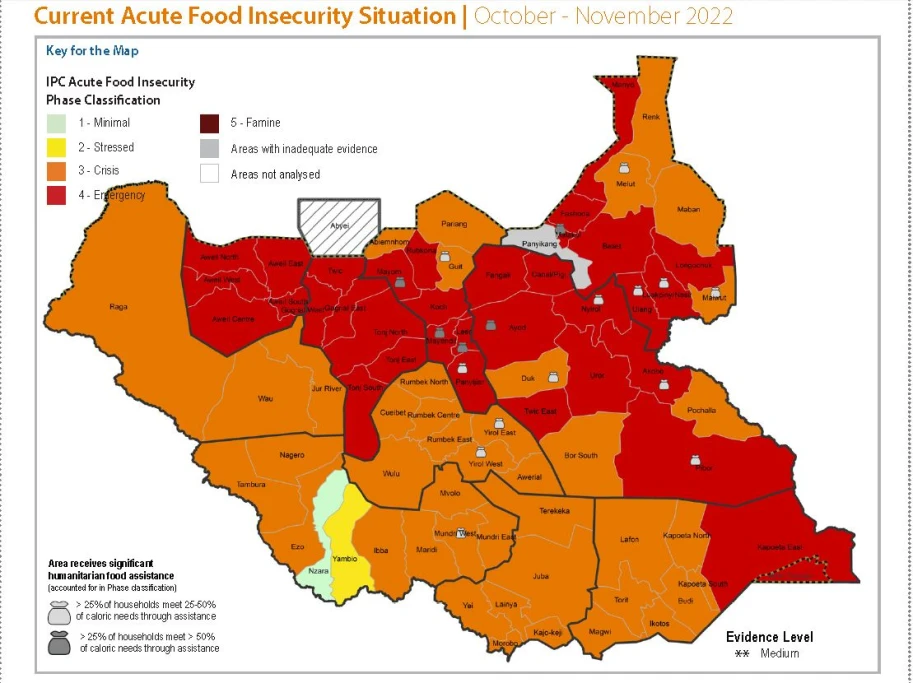
About 6.6 million people in South Sudan are experiencing high levels of acute food insecurity between October and November 2022.
This is according to a new report released by aid agencies and the government of South Sudan.
The Key Drivers of Acute Food Insecurity are conflict and Insecurity, climatic shocks, economic decline, and low production.
The Integrated Food Security Phase Classification (IPC) noted that 54% of the analysed population of 12.5 million are in high acute food insecurity.
Out of this, 2.2 million people are experiencing worse conditions and an estimated 61,000 people in Catastrophe (IPC Phase 5) acute food insecurity in Fangak, Canal/Pigi and Akobo of Jonglei State; Pibor County in the Greater Pibor Administrative Area.
“The most food insecure states between October and November 2022, where more than 50% of their populations are facing Crisis (IPC Phase 3) or worse acute food insecurity, are Jonglei (68%), Unity (66%), Northern Bahr el Ghazal (62%), Upper Nile (58%), Warrap (57%), and Lakes (57%),” the IPC report revealed.
In the lean season projection period of April to July 2023, an estimated 7.8 million people will likely face crisis or worse acute food insecurity, with 43,000 people likely to be in catastrophe acute food insecurity in Akobo, Canal/Pigi and Fangak counties of Jonglei State; and Leer and Mayendit counties of Unity State.
The drivers of these worsening humanitarian conditions are frequent climate-related shocks (severe flooding and dry spells), the macro-economic crisis, conflict and insecurity, and low agricultural production.
“South Sudan is on the frontlines of the climate crisis and day in, day out families are losing their homes, cattle, fields and hope to extreme weather. Without humanitarian food assistance, millions more will find themselves in an increasingly dire situation and unable to provide even the most basic food for their families,” said Makena Walker, Acting Country Director for WFP in South Sudan.
“We’ve been in famine prevention mode all year and have staved off the worst outcomes, but this is not enough,” he warned.
The statement also notes that the decline in food security and high prevalence of malnutrition is linked to a combination of conflict, poor macroeconomic conditions, extreme climate events, and spiralling costs of food and fuel and decline in funding humanitarian programmes in the countries.
The IPC report jointly released by the Food and Agriculture Organization (FAO), the United Nations Children’s Fund (UNICEF), and the United Nations World Food Programme (WFP) called for increased humanitarian intervention.
“Given the high levels of severe acute food insecurity in South Sudan, there is a need for immediate scale-up of multi-sectoral humanitarian assistance to save lives, and prevent the total collapse of livelihoods in the affected counties, particularly those with a high share of populations in Emergency (IPC Phase 4) and Catastrophe (IPC Phase 5) acute food insecurity,” the report said.
The report said the affected population in minimal (IPC Phase 1) and Stressed (IPC Phase 2) acute food insecurity, require resilience-building support and enhanced disaster risk reduction (DRR) strategies to mitigate the effects of climate change.
“Urgent action is also required for populations classified in Crisis (IPC Phase 3) acute food insecurity to protect their livelihoods and reduce household-level food consumption gaps.”
The South Sudan IPC Technical Working Group was vetted by a committee comprised of representatives from Government, the UN, NGOs and academia, with some members of the IPC Steering Committee attending as observers.
The report is used to determine the severity and magnitude of food insecurity and malnutrition in South Sudan to enable partners determine the level of response.
Sara Beysolow Nyanti, the UN Humanitarian Coordinator for South Sudan called on all humanitarian partners to commit to responding to the looming crisis.
“Quality data like this is critical to formulating humanitarian response plans to help meet the needs of people in the country, and these figures show the people of South Sudan need support more than ever. It’s vital we receive commitments from donors for 2023 so we can prevent a worsening of the humanitarian situation across the country.” Sara stated.
The UN Office for the Coordination of Humanitarian Affairs said resourcing for the 2023 humanitarian response in South Sudan is urgently needed within the next few months.
It said this is needed to enable agencies preposition humanitarian assistance in time for the next year to support millions of families at risk of spiralling deeper into hunger.